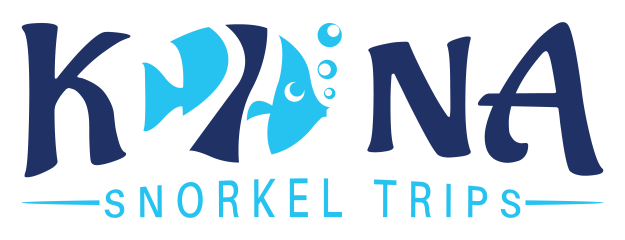Your Guide to Whale Watching Kona Big Island

Picture this: you're out on the water, the dramatic volcanic coast of Kona as your backdrop, and suddenly, a forty-ton humpback whale explodes out of the blue. That’s the kind of magic that puts whale watching in Kona on the Big Island on another level. If you're planning an adventure, this guide has everything you need to make it happen.
As Hawaii's top-rated and most-reviewed snorkel company, we at Kona Snorkel Trips bring a ton of experience to every trip out on the ocean, making sure your adventure is both safe and unforgettable. But don't just take our word for it—see what fellow travelers have to say about Kona Snorkel Trips, the top rated & most reviewed snorkel company in Hawaii.
Why Kona is a Whale Watching Paradise
The waters off the Kona coast are more than just stunningly beautiful—they're a critical sanctuary for thousands of humpback whales. Every single year, these gentle giants make the epic 3,000-mile journey from their Alaskan feeding grounds to the warm, sheltered waters of Hawaii. Why here? It's the perfect spot to mate, give birth, and raise their newborn calves.
Kona's geography is what really sets it apart. The colossal volcanoes, Mauna Loa and Hualalai, act as a natural shield, blocking the strong trade winds and creating exceptionally calm, clear seas on the leeward coast. This peaceful environment is a win-win: it's ideal for the whales, and it's perfect for those of us who want to see them.
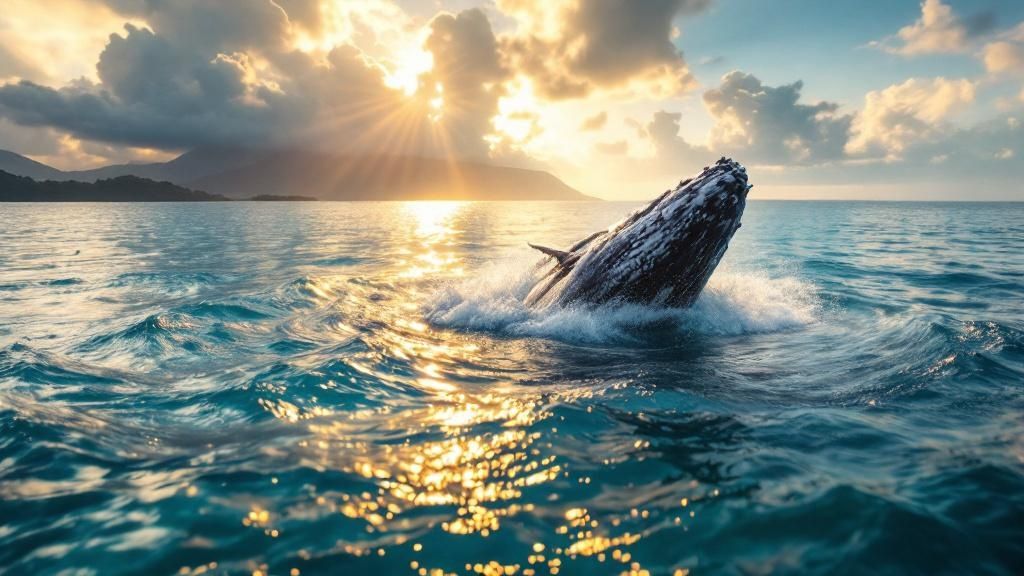
The Annual Humpback Migration
The humpback's journey is truly one of nature's greatest shows. They come to Hawaii seeking a safe harbor, a place relatively free from predators like killer whales.
Amazingly, they don't eat during their entire stay. They live completely off the fat reserves they built up feasting in Alaska's nutrient-rich waters. This means their time here is dedicated entirely to the next generation.
Here’s what they’re up to in Kona's waters:
- Birthing and Nursing: New moms give birth to calves that already weigh about a ton. They'll spend months nursing them, helping them get strong enough for the long swim back north.
- Mating Rituals: This is where the real action is. Males put on spectacular shows to compete for mates—think massive breaches, powerful tail slaps, and those famous, haunting songs that can travel for miles underwater.
- A Safe Haven: The calm, deep waters off the Kona coast are the perfect nursery. Calves have a protected space to grow, learn essential whale behaviors, and pack on the pounds before their first big migration.
Finding the Best Time for Whale Watching
When it comes to seeing humpback whales in all their glory, timing is everything. If you're hoping for an unforgettable experience whale watching on the Kona Big Island, planning your trip around their peak season is the single best thing you can do to guarantee incredible sightings.
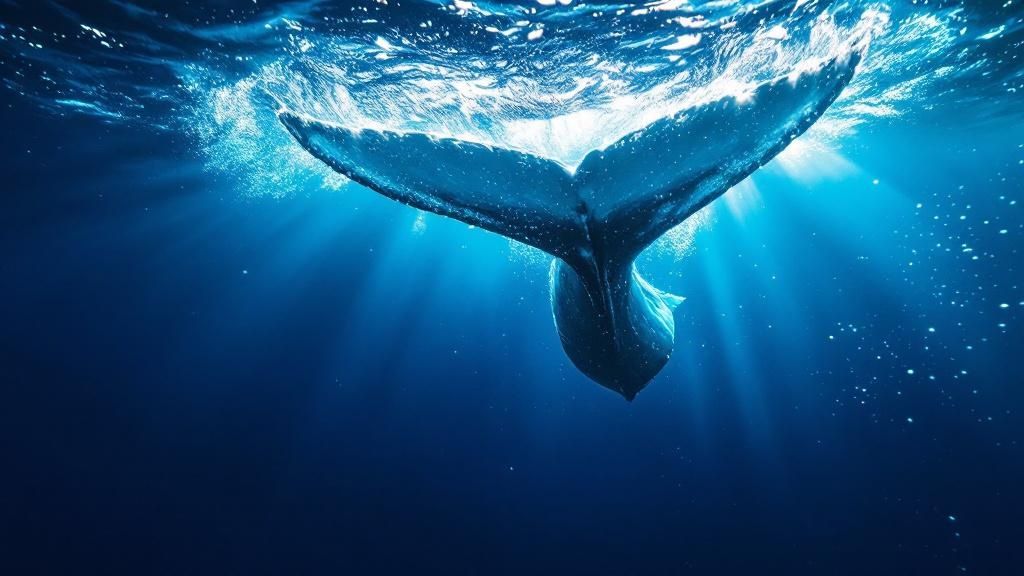
Hawaii's official whale season runs from November through April. Think of it like a massive party—the first guests start arriving in November, but the real action kicks off as thousands more make the long trek from their Alaskan feeding grounds.
While you can spot whales throughout the season, the absolute peak months are January and February. This is when Kona's waters are just buzzing with activity. Thousands of whales have settled in to mate, give birth, and raise their young, making it the most reliable time for those jaw-dropping encounters.
During this peak, you're most likely to see it all. From massive breaches as competitive males show off for mates to the touching sight of a newborn calf learning to swim right beside its mother, it’s a truly magical time to be on the water.
A Month-by-Month Guide to Kona's Whale Season
To help you nail down the perfect time for your trip, let's look at how the season unfolds. Each month offers a slightly different vibe, from the first exciting arrivals to the final, poignant goodbyes.
Here's a quick look at what you can expect each month during Kona's whale watching season.
Kona Whale Watching Season Month-by-Month
| Month | Whale Activity Level | Typical Sightings | Ocean Conditions |
|---|---|---|---|
| December | Moderate | First arrivals, active males competing for mates. Excitement is building! | Generally calm, but winter swells can begin. |
| January | High (Peak) | The highest concentration of whales. Breaches, tail slaps, and spyhops are common. | Can be variable with some winter swells. |
| February | High (Peak) | Still at maximum capacity. Lots of mating activity and the first calves are spotted. | Conditions are similar to January. |
| March | High | Lots of mothers with their newborn calves. Great for seeing nurturing behavior. | Ocean conditions often start to calm down. |
| April | Low to Moderate | Whales begin their migration back to Alaska. Sightings become less frequent but are special. | Typically calmer as winter swells subside. |
As you can see, January and February are the headliners, but March offers a unique chance to see mothers and calves. Even the shoulder months provide some wonderful opportunities. For a more detailed look, check out our complete guide to the Big Island whale watching season.
How to Boost Your Chances of an Amazing Sighting
Beyond just picking the right month, a few extra tips can really stack the odds in your favor.
Research has shown that the Big Island, especially the Kohala Coast, consistently has more humpback sightings than other spots in Hawaii. Data from the Sanctuary Ocean Count reveals that sightings here can be two to three times more frequent during the peak months.
Time of day matters, too. Whale activity is often highest in the morning. In fact, studies have shown about 50% more sightings are logged around 8:00 AM compared to midday. This makes those early-bird tours a fantastic bet for seeing the most action-packed behaviors.
How to Choose Your Ideal Whale Watching Tour
Picking the right tour is probably the most important decision you'll make for your whole whale watching adventure in Kona. It's not just about getting on the water; the boat you choose completely shapes your experience, from how comfortable you are to how close you get to the action. Ultimately, it all boils down to your personal style, who you're traveling with, and what kind of day you're picturing.
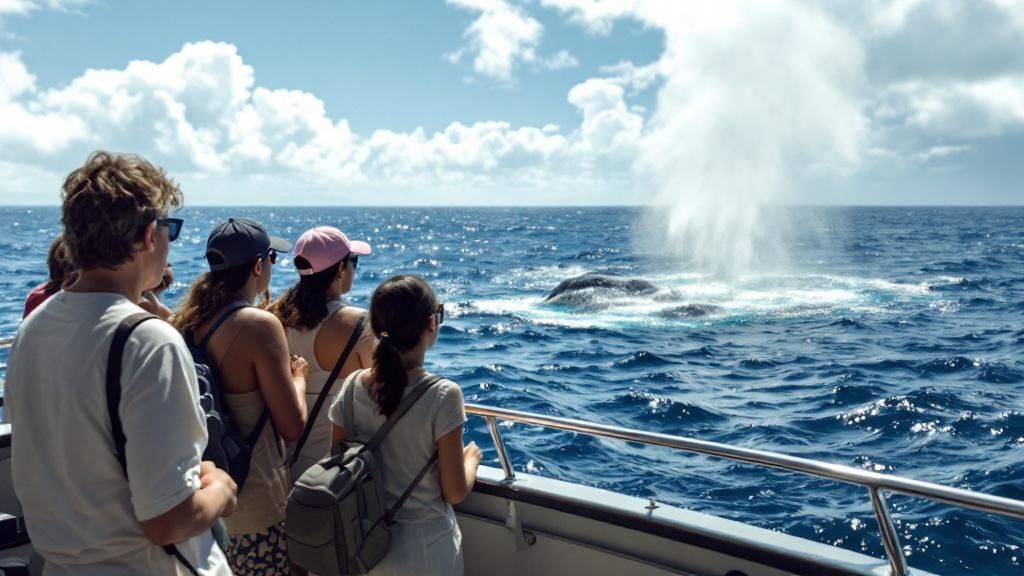
The good news is, Kona has plenty of options. You'll find everything from big, stable catamarans perfect for families to zippy zodiac-style rafts that give you a thrilling, right-on-the-water perspective. There’s really a boat for every kind of traveler. Thinking through the pros and cons of each will help you lock in the perfect trip.
Comparing Vessel Types
Your tour boat is your viewing platform for a few hours, so getting this right is key. Are you looking for a smooth, relaxing cruise with snacks and a restroom? Or are you after a fast-paced expedition that gets you right into the thick of it?
Here’s a breakdown of what you'll typically find in Kona:
- Large Catamarans and Powerboats: These are your go-to for stability, making them a fantastic choice for families with little ones or anyone worried about seasickness. They usually have great amenities like restrooms, shaded seating, and drinks, prioritizing comfort for a chill day on the ocean.
- Zodiac-Style Rafts: If you're an adventure junkie, this is your boat. These smaller, faster rafts offer an absolute blast of a ride. Because you're so low to the water, you get a uniquely intimate, eye-level view when a whale surfaces nearby. It's a real thrill.
- Medium-Sized Vessels: These boats hit a sweet spot. They offer more stability and comfort than a raft but host smaller groups than the big catamarans. This blend often leads to a more personal and engaging tour with more interaction with the crew.
Choosing the right vessel isn't just about comfort; it's about matching your adventure style. A family with small kids might prioritize the stability and amenities of a catamaran, while a wildlife photographer may prefer the maneuverability of a smaller boat for the perfect shot.
Finding a Reputable and Ethical Operator
Beyond the boat itself, the crew running the show is what makes a trip truly special. A great captain and naturalist can turn a good day into an unforgettable one. They bring the expert narration, spot whales with a trained eye, and make sure the whole experience is safe for you and respectful to the wildlife.
When you're looking at different companies, seek out the ones who are genuinely passionate about conservation. Responsible operators stick to the federal regulations like glue, which means staying at least 100 yards away from humpback whales. This is crucial for making sure the animals aren't stressed or disturbed by our presence.
Before you click "book," it's worth asking a few simple questions:
- What's your crew's experience with whale watching in Kona? A seasoned crew knows these waters and the whales' habits inside and out.
- How do you ensure the safety and well-being of the whales? You want to hear a clear commitment to following the viewing guidelines.
- What's your "whale guarantee" policy? Many of the best tours will offer you a free return trip if you don't happen to see any whales.
Taking a few minutes to vet your tour operator is the best way to guarantee a safe, ethical, and truly spectacular day with Kona's gentle giants. For more planning tips, you can dive into our in-depth guide to the Big Island whale watching season.
What to Expect on Your Whale Watching Adventure
There’s a special kind of energy on a whale watching tour, a real buzz in the air that starts the moment you check in at the harbor. Once the boat pulls away from the calm Kona coastline and points its bow toward the deep blue, the real adventure is on. Your captain and crew are the key here; these folks have spent years on these waters, and they know exactly what to look for—the subtle signs that a gentle giant is nearby.
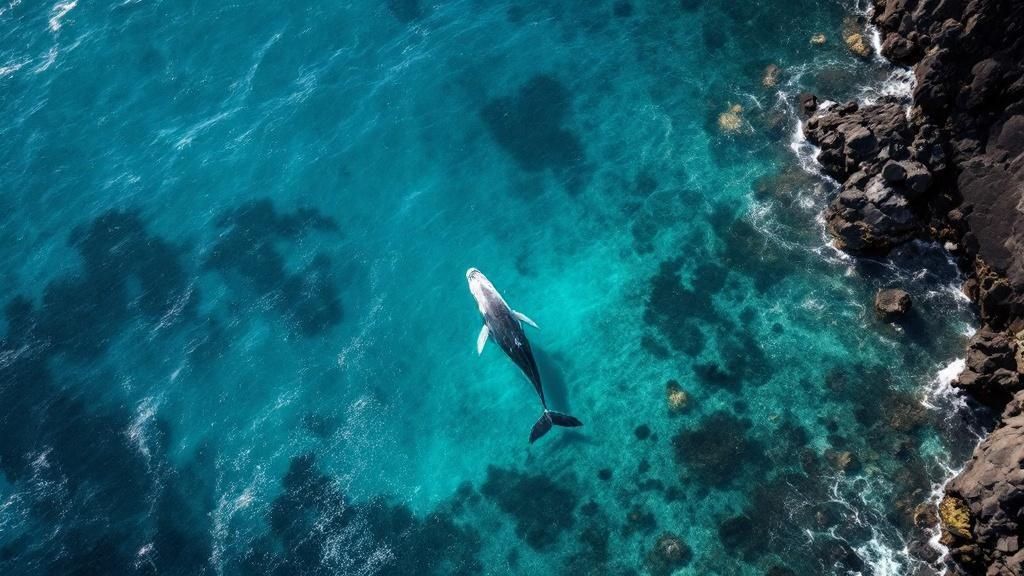
Often, the first sign is a spout. It’s a misty plume of water shooting up from the surface as a whale exhales, and it’s the signal for the crew to slow the boat. This is when everyone holds their breath, getting ready for what might happen next. It's a pure display of nature's power and grace, and you could witness any number of amazing behaviors.
Common Humpback Whale Behaviors
Watching these magnificent animals in their natural habitat is like getting a front-row seat to a masterclass in communication and raw power. Every move they make has a purpose, whether they're playing, communicating, or competing with each other.
Here are a few of the mind-blowing sights you might see on your whale watching Kona Big Island tour:
- The Breach: This is the one everyone dreams of seeing. A massive whale launches its entire body out of the water and comes crashing back down with a splash that will echo in your memory forever. It's a jaw-dropping show of pure strength.
- Tail Slap (Lobtailing): You'll see the whale's massive fluke (its tail) lift high out of the water before smacking down with incredible force. The sound is shockingly loud and travels for miles underwater—it’s thought to be a way of talking or warning other whales.
- Spy-hop: Picture a submarine periscope, but it's a whale's head. They'll poke their head straight up out of the water to get a good look around, and that often includes checking you out on the boat! It’s a super curious and almost playful behavior.
- Pectoral Fin Slap: Humpbacks have the longest pectoral fins (their "arms") of any whale, and they love to slap them on the water's surface. It’s another powerful way they make their presence known.
A great crew does more than just find whales; they read their body language. They’ll explain the science and stories behind every splash and song, turning a simple sighting into a rich, unforgettable experience.
More Than Just Whales: A Full Marine Safari
While humpbacks are definitely the stars of the show in winter, the waters off Kona are absolutely packed with other incredible marine life. Your trip often turns into a full-on marine safari. It's totally common for pods of acrobatic spinner dolphins to come race the boat, leaping and twirling through the air right beside you. You might also spot a few honu (Hawaiian green sea turtles) gliding gracefully near the surface.
The sheer amount of life out there is astounding. During a single-day count in January, observers on shore tallied 493 humpback whales just off the Big Island—way more than neighboring islands. This really drives home how vital Kona's waters are for these gentle giants. You can read more about this impressive whale count on Big Island Now.
This rich ecosystem means that even in the quiet moments between whale sightings, there’s always something amazing to see.
Finding the Best Shoreline Viewing Spots
You don’t always need to hop on a boat to get a front-row seat to the whale show. Some of the most awe-inspiring moments happen right from the shore, especially for those who prefer to keep their feet on solid ground.
Land-based viewing gives you a totally different perspective—it's a wide-angle, panoramic experience. You can track multiple pods at once, watching them interact across a massive blue canvas. The secret? Find a little elevation. A higher vantage point is your best friend, making it much easier to scan the horizon and catch that tell-tale puff of mist from a whale's blow.
Premier Land-Based Viewing Locations
When it comes to shoreline whale watching, the sun-drenched Kohala Coast is the undisputed champion. Its elevated bluffs and crystal-clear sightlines are just perfect for spotting those distant, dramatic breaches and tail slaps.
- Puʻukoholā Heiau National Historic Site: The name literally means "hill of the whale." That pretty much says it all, doesn't it? This historic site offers incredible, sweeping views over the ocean near Kawaihae, making it a truly prime location.
- Lapakahi State Historical Park: A bit further north, this park’s coastal trails provide an excellent vantage point. The slight elevation is just what you need to get a commanding view of the sea.
- Scenic Overlooks: As you drive along the highways of the Kohala and North Kona coasts, keep your eyes peeled. There are tons of little pull-offs and scenic overlooks that are perfect for an impromptu whale watching session.
Tips for Success from Shore
A little preparation goes a long way when you're whale watching from land. The single most important piece of gear you can bring is a good pair of binoculars. They’re what turn a distant splash into a clear, breathtaking view of a humpback’s acrobatic display.
Don’t forget the essentials, either: water, reef-safe sunscreen, and a hat are must-haves. These coastal spots can get hot and exposed, and you'll want to be comfortable.
And if you're wondering just how effective watching from shore can be, look no further than citizen science efforts like the annual Sanctuary Ocean Count. In one recent count, volunteers tallied an incredible 714 humpback whales across the islands, spotting dozens right from Big Island shorelines. It’s a powerful reminder of how rewarding land-based viewing can be. You can dive deeper into this amazing community effort over at Big Island Video News.
Kona Whale Watching: Your Questions Answered
Got a few questions before you book the whale watching trip of a lifetime? Perfect. Let's run through some of the most common ones we hear. Getting these sorted out now means you can just relax and enjoy the show once you're out on the water.
Is a Whale Sighting Guaranteed on a Tour?
This is the big one, isn't it? While we are dealing with wild animals in their natural habitat, your chances during peak season (December through March) are sky-high. Most reputable Kona crews report a success rate of over 95% during these prime months.
That said, many companies offer a "whale guarantee." What does that mean? Usually, if you're in the unlucky few who don't spot a whale, they'll let you come back for another trip, either for free or at a steep discount. It’s always smart to ask about the specific policy before you commit.
What Should I Wear and Bring on a Tour?
Layers are your best friend out on the ocean. Even on a balmy Kona day, the breeze and speed of the boat can make it feel surprisingly chilly, especially on those early morning tours. A light jacket or windbreaker is a non-negotiable.
Here’s a quick checklist for your day bag:
- Reef-safe sunscreen: Protect yourself and protect the delicate reef ecosystem.
- Polarized sunglasses: These are a game-changer. They cut the glare right off the water's surface, making it so much easier to see what’s just below.
- A hat with a strap: Trust us on this one. You don't want to watch your favorite hat sail away on the trade winds.
- A camera with a zoom lens: You'll want to capture every breach and tail slap, and they might be further away than you think.
- If you're prone to seasickness, it’s best to take something before you step on the boat.
How Close Can Tour Boats Get to the Whales?
Federal law is crystal clear on this, and for good reason—the whales' safety comes first. All vessels must maintain a distance of at least 100 yards from humpback whales. To put that in perspective, think of the entire length of a football field.
Now, the whales haven't read the rulebook. They are incredibly curious animals and will often approach a boat on their own terms. When that happens, a responsible captain will cut the engines and let the whales take the lead. It's an incredible experience, and it ensures the encounter is a positive one for everyone, especially the whales.
Are Morning or Afternoon Tours Better for Seeing Whales?
Honestly, you can have mind-blowing encounters any time of day. Whales are active from sunrise to sunset.
The big advantage of a morning tour is the ocean condition. The water is often calmer, almost glassy, which makes for a smoother ride and can make it easier to spot those tell-tale spouts on the horizon. For a more detailed breakdown, check out your guide to whale season in Hawaii.
Afternoon trips have their own magic, too. The wind can pick up a bit, creating more chop on the water, and sometimes that extra energy seems to get the whales fired up for more dramatic behaviors like breaching. The best advice? Pick the time that fits your vacation schedule. You can't really go wrong.
Ready to witness the giants of the deep? For an unforgettable and respectful journey into their world, book your adventure with Kona Snorkel Trips. Our experienced crew is passionate about sharing the magic of Kona's whales with you.
